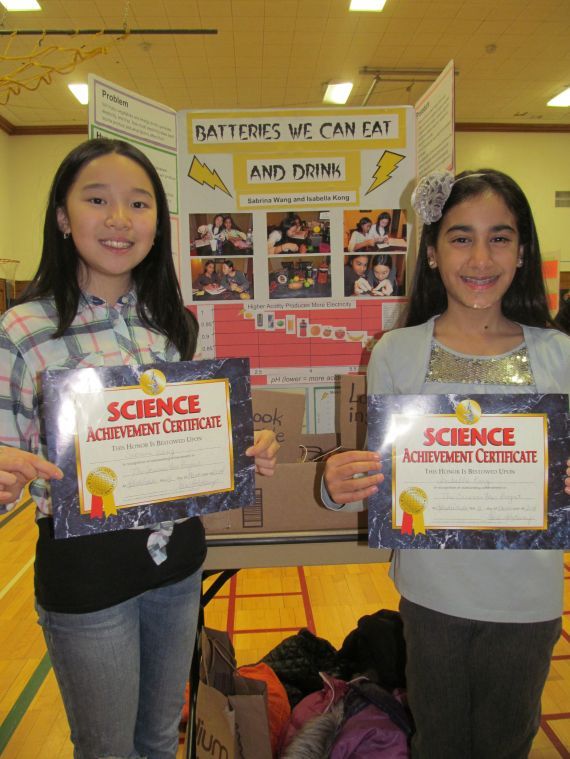
The Hillside Grade School gymnasium echoed last Thursday night with the buzz of sixth graders from the four New Hyde Park-Garden City Park elementary schools assembled to explain the science projects they had created to fellow classmates and parents,
The students had been working on the projects since the beginning of January with the hope of having their work chosen for a competition with sixth graders from other schools in Nassau County and Queens at Nassau Community College on April 5.
“They came up with their projects on their own and presented them in lab class,” said Holzkamp, a science teacher at Hillside Grade and Manor Oaks, “They’ve done very well every year.”
Last year, Holzkamp said, students from the district took first and second place in the Nassau Community College science competition.
Hillside Grade School students Adaan Khalid, Mithul George and Shawn Charles said they collaborated on a project to consider the effects of radiation generated by common electronic devices.
They said they learned in doing research that radiation – even in the relatively small doses emitted by household electronics – could contribute to causing cancer.
“We figured out that radiation kills white blood cells in your system, allowing abnormal cells to grow,” Adaan said.
The three aspiring researchers used a dosimeter to measure the radiation emitted by a variety of electronic devices – from cell phones to laptop computers and television sets. The most dangerous items proved to be older versions of laptops and TVs. A Sony TV they tested gave out 1,982 rems, a unit of radiation measurement.
Hillside Grade School students Isabella Kond and Sabrina Wang teamed up to find out whether fruits, vegetables and energy drinks could generate enough electricity to energize a light bulb.
They said they concluded after testing a variety of citrus fruits, potatoes and other common garden products that lemons had the highest level of acidity needed to generate an electrical charge – but the hands-down winners to their mutual surprise were energy drinks.
“If this would light up a light bulb, think what it’s doing to your body,” said Isabella, smiling.
Hillside Grade School students David Budhran and Panar Kangari immersed four objects – a rubber eraser, a penny, candlewax and a sponge – in seven different liquids to see what would float – or not – in water, olive oil, Gatorade, salt water, orange juice, maple syrup and tide.
“If the liquid is more dense, the object will sink. If it’s less, it will float,” Panar said, explaining their hypothesis.
The one notable exception, he said, was the sponge in Gatorade, which apparently absorbed all the sugar in the liquid and sunk.
Reva Shroff and Katie Gray wondered whether the minerals contained in certain cereals were accurate as recorded on the boxes. They tested for the presence of potassium and iron, using droplets of iodine in dry cereal – knowing iodine attracts potassium – and using a magnet to draw iron out of cereals in a water suspension.
The minerals were definitely present as indicated but, Reva said, “They exaggerate them when they advertise them.”
They concluded that Cheerios and Great Grains were the healthiest cereals of the several they tested, while Trix and Coco Puffs were suspect as the sugary concoctions they seem to be.
But the results didn’t put Katie off eating her favorite: Frosted Cheerios.
“They weren’t the healthiest, but they weren’t the worst either,” Katie said.
Bridget Koenig tested sugar’s effect on cognitive skills to answer the age-old issue that parents raise about the negative effects of sweets.
“Parents are always telling you not to eat so much sugar so you don’t bounce off the walls. So I wondered what happened if you got sugared up,” Bridget said.
She said what she discovered surprised her: consumption of sugar decreased reaction time, but improved problem-solving and observation skills, as well as long-term and short-term memory.
Bridget said she evaluated her subjects – 20 members of her nine-year-old sister’s Girl Scout troop – before and after they ate varying amounts of sugar in different candied forms. Bridget conceded that part of the experiment wasn’t entirely controlled.
She said the results were completely contrary to what she was expecting when she started out.
“I was thinking it would decrease your performance,” Bridget said.
She declined to comment on whether the results were fueling an inclination to increase her consumption of candy bars between classes.






